In my last post, I talked about why it is so important to be aware of language ideologies in the language classroom. One major reason is the class in expectations that can occur between students, teachers, and textbooks when there are ideological mismatches, as there is no ideology free classroom (despite what we sometimes pretend with “neutral” language and so on). This past week, we embarked on our first unit (housing) without the textbook (though keeping some texts from the textbook). As an introduction, I held a discussion of intentional translanguaging pedagogy with my students, as I feel like being explicit about the language ideologies informing how I design my classes is important. I wasn’t sure how this would go, as at least initially, I think translanguaging often flies in the face of what people imagine to be the “ideal” language classroom (all Arabic, all the time). While some students were certainly more interested than others, most of them seemed to like turning the lens on their language use, and to really think about it in a less restrictive way than is this Arabic (great!) or not (bad!). So, I though I would share the actual process I used in case it might be helpful in other classrooms.
First, I asked if anyone had every heard of translanguaging. No one had. I then asked if anyone had heard of code-switching, and several students immediately perked up. So, I presented the following example (taken from my data on study abroad in Jordan) of an language partner explaining why he was participating in the program (I’m presenting all these examples as screenshots of my slides as apparently I was not smart enough to pick a website platform that supports rtl languages and translanguaging:
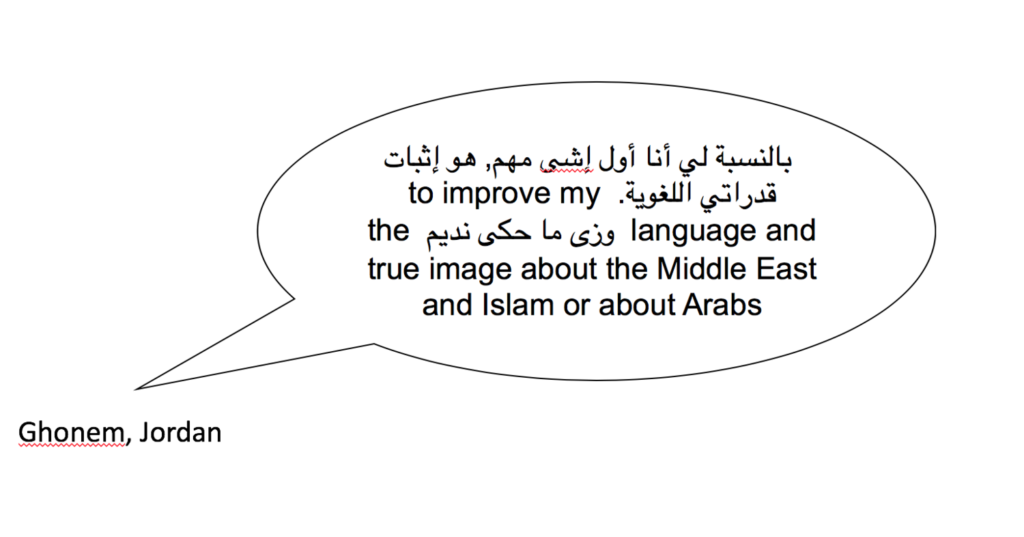
I then showed the following slide, explaining that looking at this utterance from a code-switching perspective would focus on the two codes (Arabic and English) and how the speaker was switching between them to speak.
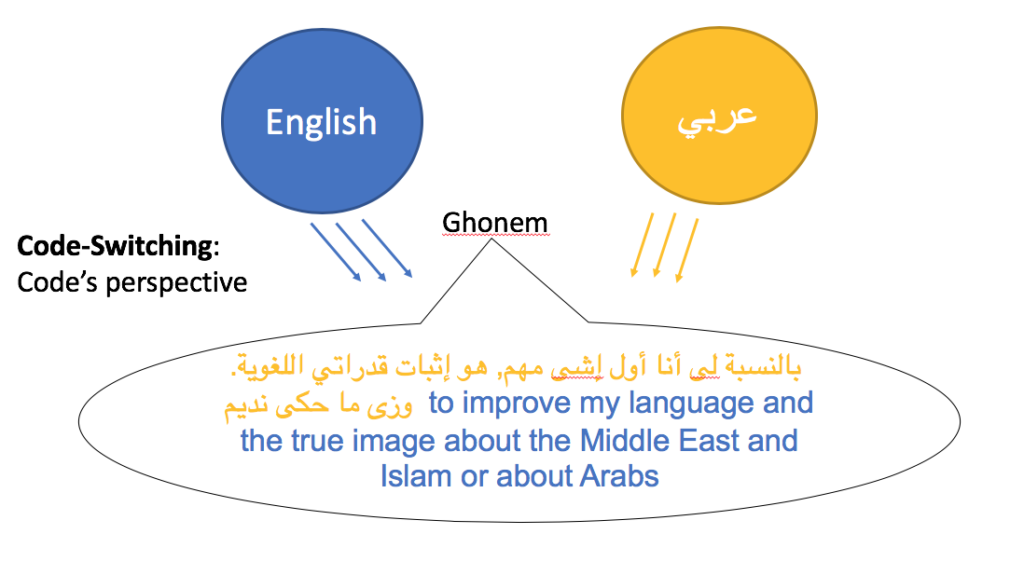
I then showed this next slide, explaining that from a translanguaging perspective, this utterance came from the speaker’s unique linguistic repertoire, which overlaps what we call certain languages. I also pointed out that it is contextually based—since the speaker was talking to me, he drew from parts of his repertoire that overlap with Arabic and English, but not Russian for example.

Then, I asked the students to discuss this idea in small groups, and in five minutes each group had to ask me at least one question about this idea. They had some great questions, which also allowed us to get into ideas like the fuzzy and liquid nature of linguistic borders, psycholinguistic representations of language, and so on.
Next, I had the students reflect upon their own linguistic repertoires, emphasizing that this was not just limited to “languages” but also included dialects. I was inspired to use Scottish Highland Dance theory as an example of how my linguistic repertoire does not overlap theirs entirely, even though we all “speak English”.*
Then, I introduced what I like to call intentional** translanguaging pedagogy with this slide, and assured students we were about to get to some actual examples:
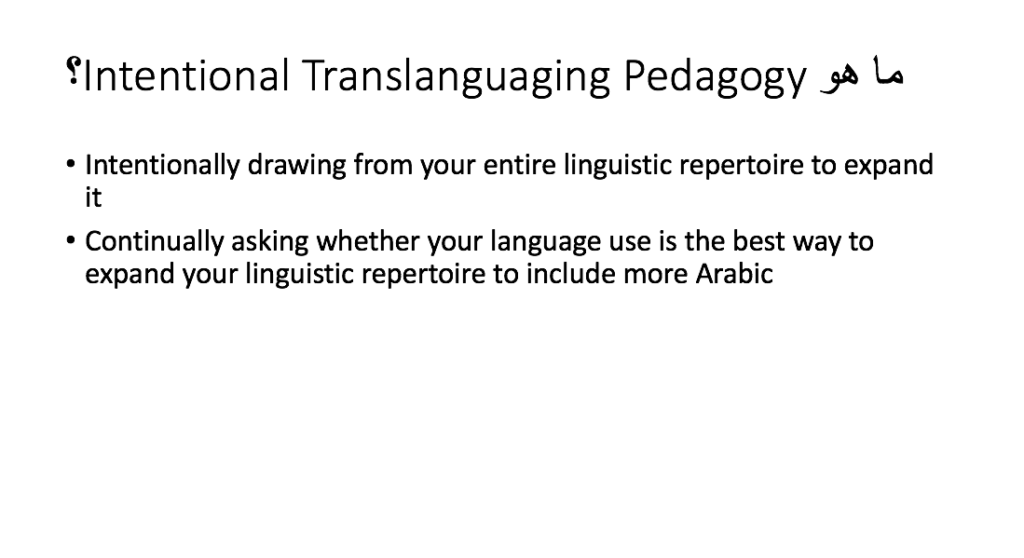
Then, we went through the following three examples, with students discussing in small groups how these could be examples of intentional translanguaging pedagogy, and then sharing their discussions with the class. These are all made up examples, but if you teach a language class, I think you will recognize their patterns.
The first example is an exchange between a student and a teacher:

Here, we discussed how when the student runs into words they don’t know in Arabic, they simply say them in English, because in a bilingual environment like the Arabic language classroom, they know their peers and teacher will understand. This allows the student to actual use more Arabic than if they had stopped to look up or ask for these words, so it is an example of translanguaging to expand their linguistic repertoire to use more Arabic. When the teacher responds, they have the linguistic repertoire to say “health insurance” in Arabic, so they are also drawing from their full linguistic repertoire to help the student learn Arabic (by understanding the English and speaking the Arabic). This is only possible because they are bilingual, and differs from if they had simply responded to the student with the Arabic words for “health insurance” and “ceramics”, correcting them. Overall, the message is taking advantage of the bilingual environment to expand one’s linguistic repertoire, rather than looking at the use of English as a failure.
The next example is between students, in the context of students translanguaging to prepare a skit to perform in front of the class and then performing the actual skit monolingually.
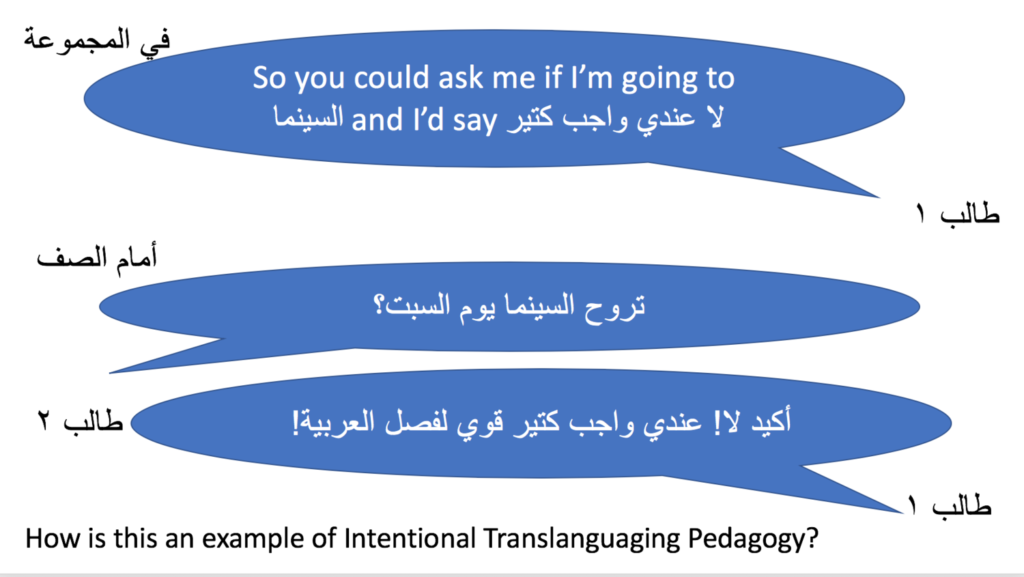
Here, we discussed how students translanguaged in process to present a monolingual product. Students noted that when planning, using English could save time and help them organize their thoughts, but it was useful to use Arabic so they were sure they knew how to say what they were planning to say and it helped them get ready. So again, this is an example of drawing from the full linguistic repertoire to expand it to more Arabic.
The challenge with the examples presented thus far is that of course they present translanguaging as a scaffold to monolingualism, and while it certainly can be a scaffold, it’s important to keep in mind that monolingualism is not necessarily the goal. To present the idea of a creative translanguaging space that transcends monolingualism, I presented the following slide with bilingual jokes. Unfortunately, I felt like I didn’t have enough time to really emphasize this point, but at least I included it.

The final example was one from outside of the classroom, as something that is coming up more and more in my own research is how a classroom focused on a monolingual, Arabic only ideal, doesn’t necessarily prepare students to interact outside of the classroom in multilingual situations, where multilingual people will, for example, not always speak only in Arabic with them. So, the final example was from a discussion between an Arabic speaker (not a teacher) and an Arabic student.

This example led to a lot of interesting discussions. Students noted that in this exchange, both parties got to use a language they might want to practice, and the student got not only language information, but cultural content information (something also of interest to students!). We discussed how this allowed both speakers to identify as speakers of both languages, something that is generally important when you’ve invested a lot of effort in learning a language! Students suggested that perhaps the Arabic speaker repeated themselves in English to ensure that the student got the language and the information, and we discussed how this could be especially important in an Islamophobic context, where speakers are concerned about misrepresentations of their culture and religion. I also pointed out that sometimes bilingual English and Arabic speakers use English for emphasis in an Arabic conversation, and this could also be an example of this practice. So, lots to think about!
I concluded with this slide, which asks what I think is a common question when we discuss translanguaging pedagogy in the language classroom, especially in the context of English speakers learning other languages:

Happily, at this point in the discussion, students were able to offer a resounding NO! I then proposed the following question as an important one to ask that is more nuanced than am I speaking Arabic or not.

This was my first attempt at introducing translanguaging pedagogy in the language classroom, and I’m sure it could be improved, particularly in terms of helping students realize that translanguaging isn’t simply a scaffold to monolingualism. However, I was impressed overall with the topics we were able to discuss in such as short period of time (about 50 minutes!). Do you have favorite strategies for teaching about translanguaing pedagogy in the language classroom? If so, let me know in the comments!
*I’m not sure transpassioning is a term, but I am always super excited when I get to use Arabic and Highland Dancing in the same context!
**In reality, translanguaging pedagogy is always intentional, but I think we are especially likely to forget this when we think about English speakers learning other languages so I put it in the term as a reminder.
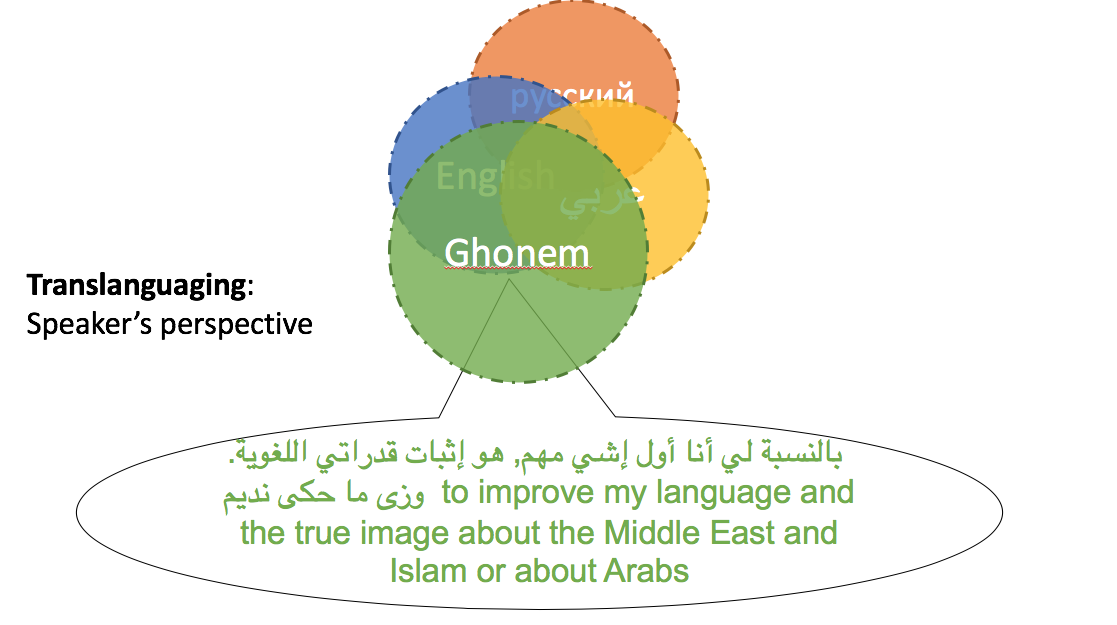
Comments
2 responses to “Curriculum Development Part 3: Introducing Intentional Translanguaging Pedagogy”
Students’ practices become very nuaced when learners share a third or heritage language in their linguistic and cultural repertoire, and these days very diverse classrooms are not that uncommon.
Really enjoyed your post, Emma! Wonderfully rich examples of translanguaging in action, that actually help to explain and explore this linguistic concept further. Looking forward to more examples from your Arabic language classroom, and to sharing these with my students of linguistics <3